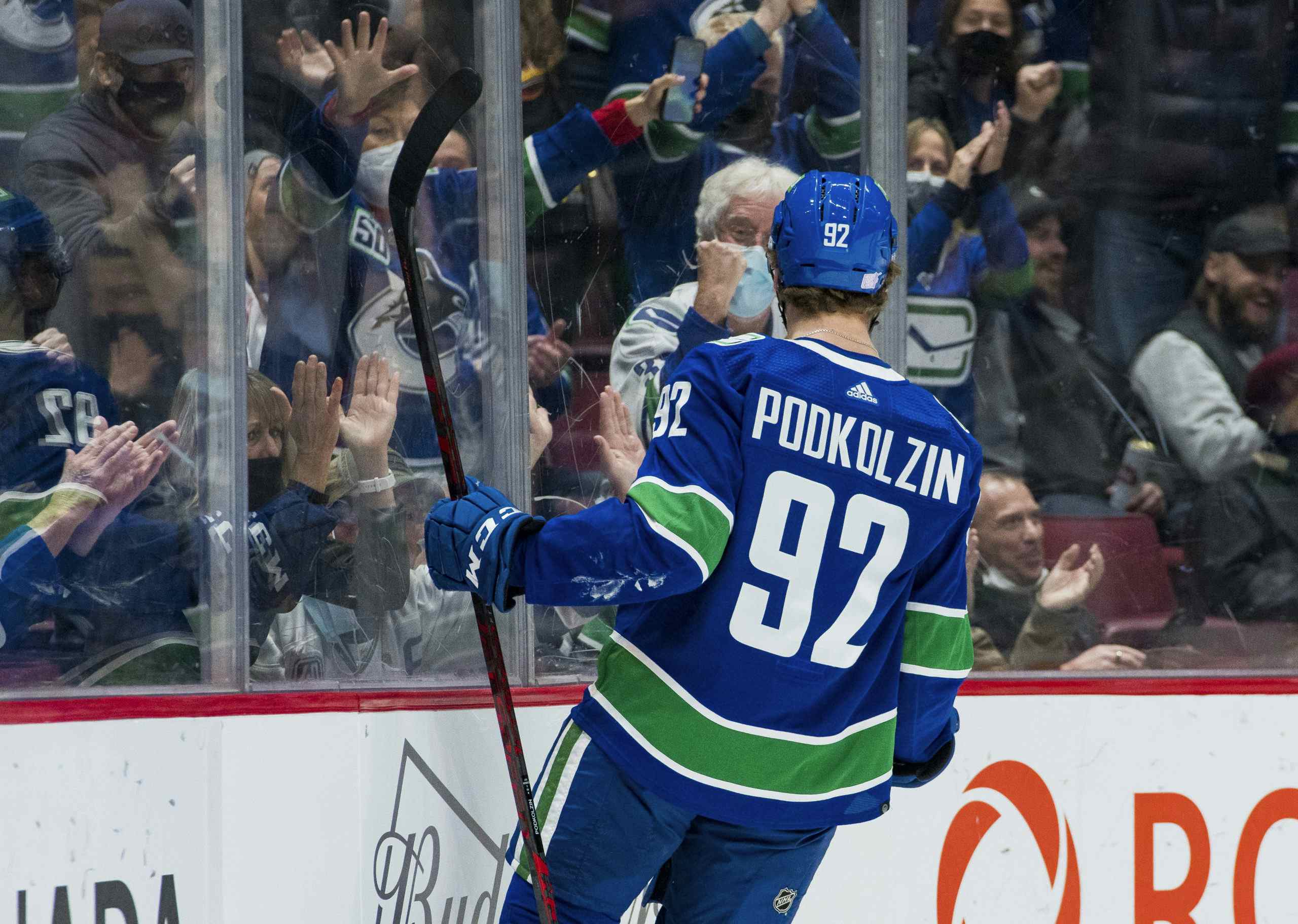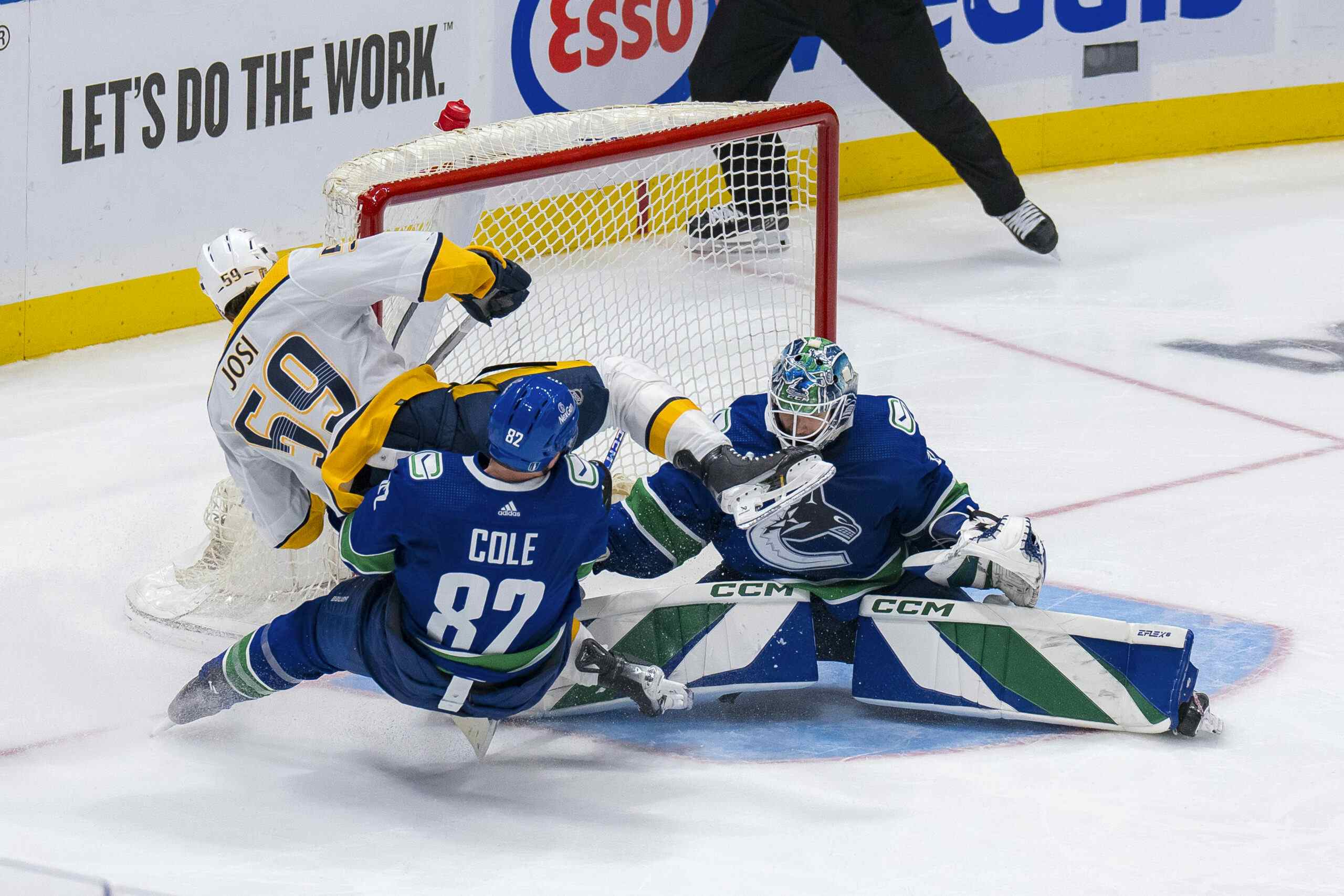For the first time in years, the Canucks have a real top-six

4 years ago
The term “top-six forward” gets thrown around a lot by fans and media alike, but most people don’t really know what it means. While some observers can certainly recall a time when second-line forwards were putting up 50-60 point seasons, the reality is that those days are long behind us.
Unfortunately, it seems that a large portion of Canucks fans have inflated expectations of what top-six production looks like. This becomes readily apparent when you read through some of the criticism that’s been directed at the team lately.
A large portion of this criticism has been centred around a pair of streaky offensive forwards in Tanner Pearson and Josh Leivo. One needs only to search their names along with the search term “top six” on twitter to get a sense of what I mean:




You get the idea.
A lot of this criticism strikes me as a tad unfair. Sure, Pearson and Leivo and a number of the team’s other middle-six forwards are streaky scorers, but that’s true of the vast majority of forwards in the NHL, even the elite ones.
For the first time in years, the Canucks are actually getting solid top-six production. The top line of Elias Pettersson, Brock Boeser, and J.T. Miller has been a credible top line at even-strength and absolutely electric on the power play, and there have been a number of support pieces that have stepped up in different situations to produce secondary offense as well. While there are a number of legitimate qualms to be had with the team’s roster construction and long-term plan, the truth is, they’ve been a fairly solid group offensively through the first two months of the season.
Defining Terms
The issue with the term “top-six forward” is that it’s both vague and fails to describe the reality of how forwards are deployed in the modern NHL. It’s very rare that players see all or even the majority of their time at even-strength on one of their team’s top two lines. What’s more common is that teams will have three or four core offensive players, and an additional group of support forwards than can be relied upon to help produce offense when deployed alongside those players. Sometimes this means rotating versatile wingers into the top six to play an offensive role, or into the bottom-six to play more of a checking role; but other times teams may employ more of a “top nine” strategy by balancing scoring across their top three lines.
For the purposes of this exercise, we’re going to define a top-six forward as a player who appears in the top 186 players in a number of different offensive categories: total points, points per game, even strength points, and points per 60. Logic dictates that if there are 31 teams in the league, there will be 93 top-line forwards and 93 second-line forwards. You can argue whether or not a player is a good top-six contributor, but that’s not the point of this exercise. The 90th highest scoring forward in the league may not be a great top-line player, but he still qualifies.
Total Points
The Canucks currently have four forwards sitting in the top 93: Elias Pettersson, J.T. Miller, Brock Boeser, and Bo Horvat. Out of those players, none are below the top 40 in scoring among forwards, which means they could be described as producing at a high-end first-line rate in all situations. They also have another player, Tanner Pearson, who sits just outside the top 93 at 100, and could be described as producing at a high-end second-line rate in all situations. After those players, they also have Josh Leivo, Adam Gaudette, and Jake Virtanen, whose totals all rest towards the middle-to-bottom half of the next 93 forwards in NHL scoring, making them average-to-fringe second line players in all situations.
Points Per Game
Another way to determine performance tiers for top-six production is to look at points per game. By sorting players by points-per-game, we eliminate the inherent advantages held by forwards who have played more games, and the disadvantages held by players who have hit injuries. For the purposes of this exercise, I left out players with less than 15 games played to eliminate noise.
When sorting by points-per-game, the same group of Canucks forwards continues to look impressive- albeit slightly less so. Elias Pettersson is no longer a top-ten producer in the league, and Bo Horvat is closer to the middle of the group, but all four players still qualify as high-to-middle-end top line forwards.
Adam Gaudette comes out looking more impressive, sitting at 93rd overall among forwards in P/GP, putting him right on the dividing line between first and second-line forwards. While this can largely be attributed to a small sample size and some luck on the power play, it’s still impressive for a sophomore and former fifth-round pick.
Tanner Pearson is a little lower down the list at 117th, but he still qualifies as a high-end second line forward by this metric, while Leivo still qualifies as a fringe second-line producer at all situations. Unfortunately for Jake Virtanen, he no longer qualifies as even a low-end top-six forward when adjusting for games played.
Even with Virtanen missing the cut, the Canucks still have six forwards who qualify as top-six players. So far, so good.
Even Strength
When we look solely at even-strength production, the top end of the Canucks forward group begins to look less impressive. No Canucks forward makes an appearance in the top 40 of the 93 best even-strength point producers, with Elias Pettersson being the best Canucks forward at 43rd with 15 ES points. Despite the dip, the Canucks actually have six players that qualify as top-line producers at evens; with JT Miller, Brock Boeser, Bo Horvat, and Jake Virtanen all sitting into the middle-to-low-end of the list, and Josh Leivo squeaking in under the wire at 89th. After that, We’ve got Tanner Pearson rounding out the group as the team’s only player to qualify as a second-line producer at evens – that’s a good thing, though, because the other six players all qualify as first-line producers by this one very specific category.
Rate Stats
Individual points-per-60 (P/60) are generally considered one of the best ways to evaluate how a player is producing at even-strength because it accounts for the differences in deployment that are going to arise between players. Often, the counting stats of a player that eats a lot of minutes can seem impressive at first glance, when really, they’re producing below what you’d expect from a player who sees a lot of ice-time. Unfortunately for the Canucks, P/60 rankings are going to put a lot of their forwards at a disadvantage, because the team has seen so much success on the power play.
Somehow, the team still managed to come away with three forwards that qualify as top-line producers, although they aren’t necessarily the ones you’d expect. Elias Pettersson is there, sitting comfortably at 57th overall in P/60, but just ahead of him are Jake Virtanen and… Brandon Sutter.
Obviously, we shouldn’t expect that to be sustainable over the long haul, given Sutter’s track record of poor rate stats at even strength, but it still reflects well on both him and the coaching staff. He’s clearly thrived playing softer minutes, and while I expect his production to come back down to earth when he returns from injury, this exercise doesn’t account for that. For now, he qualifies.
After those three, we’ve got a pair of usual suspects in J.T. Miller and Brock Boeser, coming in at 104 and 122, with Josh Leivo sandwiched between them at 108, meaning all three players have produced at a high-end second line rate at evens. While that may be a mild disappointment for Miller and Boeser, it’s a huge positive for Leivo, and with the former two players seeing so much success on the power play, I’d still feel positive overall about how the group has fared at even strength.
Finally, rounding out the list are Bo Horvat, Adam Gaudette, and Tanner Pearson, who all rank in the mid-to-low end of second-line producers. Overall, that’s quite good, considering the team has seen most of its offensive success come on the power play.
What does it all mean?
It’s unclear to what extent the team’s offense will hold steady over the course of the season, but it’s fair to say that, at the very least, the Canucks have had a credible top-six group thus far. When looking at raw points or points per game totals, the Canucks have a number of players who meet performance tiers not only for top-six scoring, but top-3 scoring as well. At even strength, the numbers have been less impressive, but a few of the Canucks depth forwards have stepped up to keep the team’s offense clicking at a healthy clip. Most interestingly, the Canucks two most maligned forwards in Tanner Pearson and Josh Leivo appear most consistently across all four categories as credible if not above-average second-line forwards. If anything, the Canucks’ biggest issue seems to be that the team’s top offensive forwards have struggled, in a relative sense, to produce offense at even strength.
While the Canucks could probably use to add another forward or two that can be relied upon to produce offense, they’ve fared remarkably well in the secondary scoring department. Players like Leivo, Pearson, and even Adam Gaudette and Jake Virtanen have been credible secondary scorers so far, even if they’ve had other issues, and suggesting otherwise doesn’t pass the sniff test. Overall, it’s a huge improvement over last year, and one that hasn’t been noticed nearly as much as it should.
If anything, the fact that the Canucks continue to serve as a reminder that they still have a lot of work to do. They’re a healthy 11th in the league in expected goals for, but defensively, they’re lagging behind, sitting at 18th in expected goals against. This indicates that their young players need to continue to develop their two-way game, or that they need to continue to revamp the back-end and the bottom half of their roster.
Either way, for the time being, we can take solace in the fact that the offense as a whole has taken a massive step forward this season, and players like Leivo, Pearson, and Virtanen in particular have been a big part of that, helping the team get the kind of secondary scoring that they’ve been lacking for most of the latter half of the 2010s.





